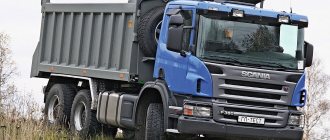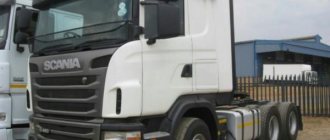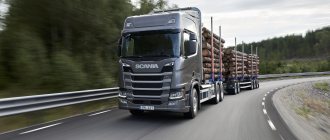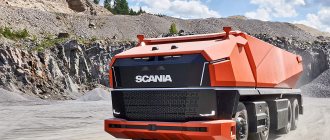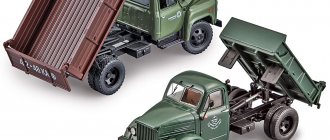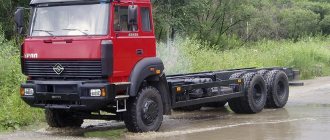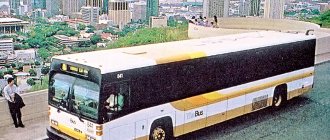Characteristics of Scania / Scania
The Swedish concern Scania CV AB is one of the world leaders in the production of heavy trucks and buses. It is an international corporation operating in more than one hundred countries around the world. Ninety-seven percent of products are sold outside Sweden. Since the establishment of the company, more than 1,000,000 trucks and buses have been produced! The company was founded in 1901 on the basis of the Swedish branch of the English company Humber, which produced bicycles. And, it must be said, these bicycles were of excellent quality: for their strength, reliability and stability, they received the nickname “stools on wheels.” The company was located in the small town of Malmen in the south of the country. And the name itself - Scania - reflected this geographical fact: it denotes belonging to the southern Swedish region of Scan.
Also in 1901, Scania released its first passenger car, and at the end of the next year, its first truck. Its “fathers,” engineers Anton Svensson and Reinhold Thornssin, argued for a long time about where to place the engine. One believed that it should be installed in the front, the other - in the back. As a result, a “golden mean” was found - both figuratively and literally: a 2-cylinder 12-horsepower engine was placed in the middle part of the chassis, under the driver’s seat. This vehicle could transport one and a half tons of cargo at a speed of up to 15 km/h. Over the next few years, 3-3.5 ton trucks were built in limited quantities.
It is interesting that in 1902, simultaneously with the first-born Scania, another Swedish company produced its first truck - the Vabis enterprise in Södertälje, which until then had been building railway cars.
In 1911, as a result of the merger of these enterprises, Scania-Vabis was formed, which focused on the production of automobiles. In the first year, it produced 40 cars, 23 trucks and one bus, which was a lot at that time.
Two years later, a huge fire broke out at the Södertälje plant, destroying almost all of the production equipment. The most modern equipment was installed to replace the burned-out equipment and the machine park was completely updated. And not least thanks to this, Scania-Vabis successfully completed numerous orders for the army during the First World War.
In 1921, Scania-Vabis was declared bankrupt and radically reorganized. In 1925, it was necessary to abandon the production of passenger cars and direct all efforts to the more profitable production of trucks and buses.
Sales of buses went especially well, and in the 1930s the company produced twice as many of them as trucks. The Bulldog bus, launched into production in 1932, was very popular. It had a progressive carriage layout that was just becoming fashionable at that time: there was no hood protruding from the front, and the driver was located directly in the front of the body, to the right of the engine. (In those years, left-hand traffic still existed in Sweden). As a result, with the same overall length as a bonnet bus, the useful capacity of the vehicle has become larger. Inspired by the success of the bus, designers began to produce trucks of a similar layout - with a cab over the engine.
Diesel engines, which are more economical than their gasoline counterparts, have begun to be actively used on trucks. Scania-Vabis also did not remain aloof from this process. Already in 1931, it began producing cars equipped with 80-horsepower Hesselman engines, and in 1936 it switched to diesel engines of its own production.
During the Second World War, gasoline was a bit tight in Europe, and gas-generating cars powered by... wood lumps became widespread in all countries. Burning in a special “furnace” - a gas generator with limited access to oxygen, they released flammable gas that entered the engine cylinders. Scania-Vabis also began producing such trucks. During this period, the company reconsidered its priorities: the basis of production became not buses, but trucks. Various military orders were also carried out, in particular, tanks and armored personnel carriers were built. The company developed successfully.
In the 50s a new company strategy was adopted. Active promotion to foreign markets began. The production of trucks increased. In 1959, 4,500 vehicles were produced - three times more than in the pre-war 1940.
In 1962, a truck and bus plant was built in distant Brazil, in Sao Paulo. Two years later, the company expanded its presence in Europe: it began producing trucks in the Netherlands, in Zwelle.
The technical improvement of cars was also in full swing. Turbodiesels appeared on Scania-Vabis vehicles in 1959. Soon, cabs that were specially tested for strength began to be used, which significantly increased their safety in the event of an accident. In 1969, the new 14-liter turbodiesel DS 14 was released, which embodied the idea of an engine operating at low speeds. This increased the durability and efficiency of the motor, and also reduced its noise.
In the same year, the company merged with its compatriot, Saab, which produces cars and aircraft. This is how the Saab-Scania concern was formed. Since that time, trucks and buses have changed their brand: instead of Scania-Vabis, they began to be called simply Scania. And the joint production later disintegrated, and since 1995 Scania again became an independent company.
In the 70s, a successful attack on foreign markets continued. In 1976, the enterprise came into operation in Argentina, in the city of Tucumas. And it was followed by factories in other countries, including the USA, Mexico, Australia...
Over the next decade, the company became a leader in the production of heavy-duty trucks. All of Scania's previous experience was concentrated in the so-called 2-series vehicles, the production of which began in 1980. These were vehicles with a gross weight of 16.5 to 32 tons. They were equipped with engines of 8, 11, 14 liters. Since 1982, intercoolers began to be installed on these turbodiesels, i.e., an intercooling system for the charge air. This increased power and reduced fuel consumption.
Among other things, the 2 Series cars had a new, expressive appearance, designed by the famous Italian automobile “couturier” - stylist Giorgio Giugiaro.
In 1987, Scania 3 Series trucks appeared. Their total weight was 17–32 tons. They were equipped with turbodiesels with a working volume of 9, 11 and 14 liters. The following year, an electronic fuel injection system - EDS - was used for the first time in Europe on a 14-liter diesel engine. And it is no coincidence that the vehicles of this series were awarded the prestigious title of the best European truck of 1989 - “Truck of the Year'89”. However, the designers did not rest on their laurels and continued to improve the car. In 1990 it features an innovative turbo-compound diesel engine with a record efficiency of 46%. In 1991, hoodless and hooded modifications appeared with improved aerodynamics, and with the appropriate name - “Streamline”. Reduced air resistance reduced fuel consumption by 4-5%.
In 1996, vehicles of the new 4th series appeared, with a gross weight from 18 to 48 tons, which were awarded the honorary title “Truck of the Year'96”. And they also continued to improve. Today they have Euro 3 compliant engines, disc brakes, Opticruise automated gearshift systems and much more. And recently the company released the Griffin machine - an inexpensive and durable modification, specially designed for operation in the conditions of the CIS countries.
In 2003, Scania went beyond the usual restyling and introduced a completely new cab with increased space behind the driver - the Longline. The new cab will be available exclusively in combination with the 580 hp V8 engine and will go on sale in September. Let us recall that in 2002, at the commercial vehicle exhibition in Hannover, Scania presented a conceptual development - a tractor with an apartment cabin. This car aroused great interest among customers and journalists throughout Europe and, a year later, the production model went on sale. The Longline cabin is ideally suited for multi-day trips and will allow the driver to avoid any everyday inconveniences. This, in turn, should have a positive impact on the quality of transportation. Production of Longline cabs will be carried out at the LaxE Special Vehicles plant.
Website: www.scania.com
Representative office in Russia:
Scania G480 10×4 dump truck with coal body
The high-performance Scania G480 CB10x4EHZ mining dump truck with a coal body has a payload capacity of 36 tons and is designed for transporting coal and other materials with a density of up to 1000 kg/m3 in quarries, deposits and on public roads. Loading is preferable with hydraulic excavators or front wheel loaders with a bucket volume of 2.5 - 6 m3.
Overall dimensions (in mm)
Body
- Reinforced, with rear unloading
- Geometric volume of the body (without “cap”) 36 (40) m3
- Body material - high quality steel Hardox / Raex 450
- bottom 10 mm
- walls 6 mm
- The front side is straight with a protective visor against shedding
- Heating of the body with exhaust gases
- High-strength chrome-plated cylinder
- Hydraulic equipment HYVA
- Mounting bracket and winch for raising/lowering the spare wheel
Gradeability (%)
Turning Radius
- Inner radius 9,852 mm
- Radius between curbs 14,011 mm
- Radius between walls 14,628 mm
ADDITIONAL EQUIPMENT INCLUDED IN THE STANDARD EQUIPMENT OF THE DIP TRUCK
- High-mounted air intake with additional cyclone-type protective filter
- Analog hour meter
- Electrically heated fuel filter-moisture separator
- Protective grilles for front and rear lights
- Intercooler insulating curtain
- Rotating lights on the cab roof
- Lockable radiator trim and fuel filler cap
- Sound signal for vehicle reversing
- Wheel chocks
- Step lighting
- Warning triangle
- Hydrocorrector of headlight level
- Fire extinguisher and first aid kit
- Slope holding system
- Set of tools
- Traction Control
- Spare wheel on disk assembly
- Tachograph
- Jack capacity 10 tons
- Two 180 Ah batteries
- Tire inflation hose 20 meters long
- Generator 150 A
- Coolant crystallization temperature -40C
- Additional lights in the cab canopy
- Installed fleet management system (Scania FMS)
OPTIONAL EQUIPMENT NOT INCLUDED WITH THE DIP TRUCK
- Body volume from 20 to 45 m3
- Removable tailgate, with cable drive
- Other thickness of body plates (bottom - 8-17 mm, walls - 8-12 mm)
- Gear ratio 5.68
- Cabin type CG14/CP14/CP16
- Painting of the cabin and body at the request of the customer
- Two 225 Ah batteries
- “Arctic” oils for engines and transmission units
- Autonomous diesel engine preheater
- Automatic fire extinguishing system for engine compartment
You can get more detailed information about the technical characteristics, equipment, prices, terms of sale of cars, as well as the purchase of a Scania G480 10×4 mining dump truck with a body for coal by contacting the managers of our company.
Scania G440 6×6 mining dump truck
The high-performance all-wheel drive Scania G440 CB6x6EHZ dump truck with a rock body has a load capacity of 25 tons and is designed for transporting rock, overburden and other materials with a density of up to 1600 kg/m3 in open-pit mines, quarries and on public roads. Loading is preferable with hydraulic excavators or front wheel loaders with a bucket volume of 2 - 5 m3.
Overall dimensions (in mm)
Body
- Reinforced, rectangular with rear unloading
- Geometric volume of the body (without “cap”) 16 m3
- Body material - high quality steel Hardox 400/450
- bottom 12 mm
- walls 8 mm
- The front side is straight with a protective visor against shedding
- Tailgate opening with hinges at the top
- Heating of the body with exhaust gases
- High-strength chrome-plated cylinder
- Hydraulic equipment HYVA
- Mounting bracket and winch for raising/lowering the spare wheel
Gradeability
Turning Radius
Internal radius 5,147 mm Radius between curbs 8,867 mm Radius between walls 9,479 mm
ADDITIONAL EQUIPMENT INCLUDED IN THE STANDARD EQUIPMENT OF THE DIP TRUCK
- High mounted air intake with additional
- Analog hour meter with cyclone type protective filter
- Electrically heated fuel filter-moisture separator
- Protective grilles for front and rear lights
- Intercooler insulating curtain
- Rotating lights on the cab roof
- Lockable radiator trim and fuel filler cap
- Sound signal for vehicle reversing
- Wheel chocks
- Step lighting
- Warning triangle
- Hydrocorrector of headlight level
- Fire extinguisher and first aid kit
- Tachograph
- Jack capacity 10 tons
- Two 180 Ah batteries
- Tire inflation hose 20 meters long
- Generator 150 A
- Coolant crystallization temperature -40C
- Additional lights in the cab canopy
- Installed fleet management system (Scania FMS)
OPTIONAL EQUIPMENT NOT INCLUDED WITH THE DIP TRUCK
- Body volume from 12 to 25 m3
- Increasing the thickness of the body plates (bottom - 15-17 mm, walls - 10-12 mm)
- Cabin type CG14
- Painting of the cabin and body at the request of the customer
- Two 225 Ah batteries
- “Arctic” oils for engines and transmission units
- Autonomous diesel engine preheater
You can get more detailed information about the technical characteristics, equipment, prices, terms of sale of cars, as well as the purchase of an all-wheel drive mining dump truck Scania G440 CB6x6EHZ with a body for rocks by contacting the managers of our company.
